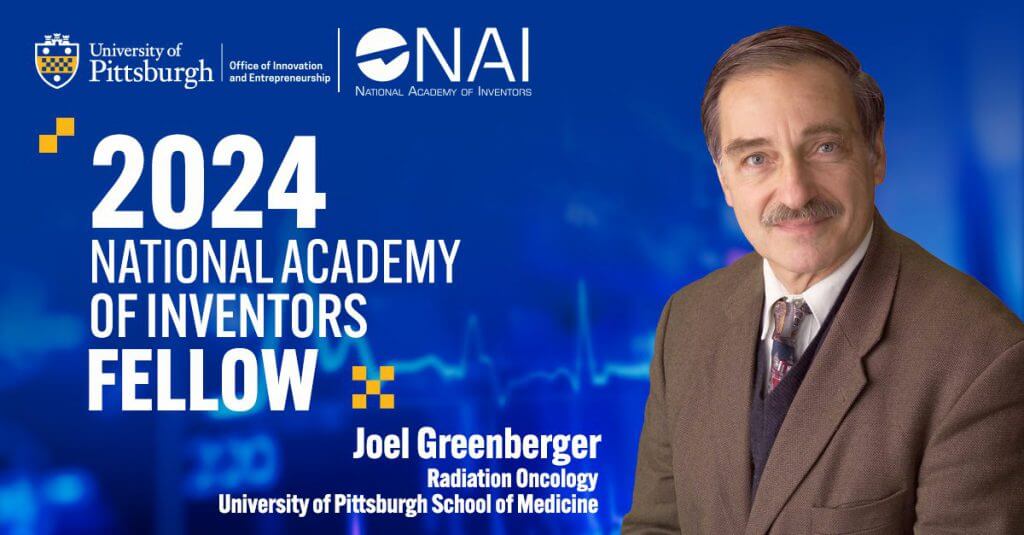University of Pittsburgh faculty members Peter Wipf and Joel Greenberger have been elected Fellows of the National Academy of Inventors.
Wipf, a Distinguished Professor in the Department of Chemistry, is one of Pitt’s most prolific and collaborative inventors. His 77 patents, and counting, are far and away the most of any active Pitt faculty member. Greenberger, Chairman Emeritus of the Department of Radiation Oncology, is a pioneer in creating small molecules for preventing and treating radiation exposure damage, either from chemotherapy in cancer treatment, or exposure from nuclear power plants or weapons.
The NAI Fellows program highlights academic inventors who have demonstrated a spirit of innovation in creating or facilitating outstanding inventions that have made a tangible impact on the quality of life, economic development, and the welfare of society. Wipf and Greenberger are the 15th and 16th Pitt faculty to be named NAI Fellows since its inaugural class in 2015.
The 2024 Fellows hail from 135 research universities, governmental and non-profit research institutions worldwide and their work spans across various disciplines. They collectively hold over 5,000 issued U.S. patents and whose innovations are making significant tangible societal and economic impacts today and will well into the future.
“Throughout their distinguished careers Drs. Wipf and Greenberger have exemplified the spirit of what is possible at Pitt when innovators are determined to not only explore the frontiers of science but also shepherd their innovations from the lab to the market where they have the potential to impact the world,” said Evan Facher, Vice Chancellor for Innovation and Entrepreneurship.
Prodigious Drug Discovery Collaborator

In addition to his primary appointment, Wipf holds appointments in the Department of Pharmaceutical Sciences and the Department of Bioengineering. He is the Director of the university’s Combinatorial Chemistry Center and co-leads the Cancer Therapeutics program for Pitt’s clinical partner, UPMC.
His impact extends beyond his own inventions to the dozens of collaborators, both across Pitt and from other institutions, who have sought out his nearly unparalleled expertise in synthetic, medicinal, organometallic, and heterocyclic chemistry to help breathe life into their innovations. His drug-discovery efforts have ranged across a broad spectrum of therapeutic areas, including oncology, neurodegeneration, fibrosis, neuromuscular diseases, inflammation, and immunology. Dr. Greenberger is counted among his collaborators.
Dr. Wipf’s intellectual property has been licensed 31 times and formed the basis for six startup companies. He has pioneered the synthesis of natural compounds that have advanced to clinical trials, including cancer therapeutic Sonolisib , licensed by Oncothyreon (now Seattle Genetics). His most recent startup, KeViRx, has raised $3 million in funding to advance pre-clinical studies.
Among his many honors, he served as Chair of the Pharmaceutical Sciences Section of the American Association for the Advancement of Science and is an elected Fellow of the American Chemical Society and the Royal Society of Chemistry.
“Dr. Wipf’s innovative skills in medicinal, synthetic, and computational chemistry and his productive collaborations have led to numerous milestones that continue to advance the fields of medicinal chemistry, pharmacology, and therapeutics,” said John Lazo, Harrison Distinguished Professor Emeritus in the Department of Pharmacology at the University of Virginia, who is co-inventor on 10 patents with Wipf.
Pioneer of Radiation Exposure Prevention and Treatment

Greenberger is the principal investigator on the University of Pittsburgh Center for Medical Countermeasures Against Radiation (CMCR), one of four such centers in the United States. He oversees four projects dealing with the concept of “radiation disease”, which describes categories of organ systems failure related to the time after total body irradiation exposure. His research efforts focus on multiple forms of irradiation-induced cell death including apoptosis, necroptosis, ferroptosis, and secondary injury mediated by release of inflammatory cytokines from irradiated tissues.
The National Institutes of Health has continuously funded his lab for 40-plus years; and his team lays claim to 44 patents and counting. Among their breakthroughs: preclinical models of the use of a lead compound to ameliorate irradiation toxicity in patients with head, neck and esophageal cancer.
“Dr. Greenberger is one of the most inventive researchers I’ve known,” said Bevin Engelward, professor of biological engineering at the Massachusetts Institute of Technology, who has collaborated with Greenberger for more than 20 years. “One of the things that stands out in my mind about Dr. Greenberger’s work is that he has not settled on one strategy, but rather he has invented several approaches toward radiation mitigation.”
Engleward pointed specifically to Greenberger’s development of a molecule to treat radiation exposure, called JP4-039.
“Dr. Greenberger has stepwise moved this molecule from concept to application,” he said, pointing to how he first demonstrated that it could protect against lethal radiation, then developed a way to deliver it to esophageal cells to protect patients undergoing radiation for throat cancer, as well as a method to deliver it to the skin via microneedle arrays.